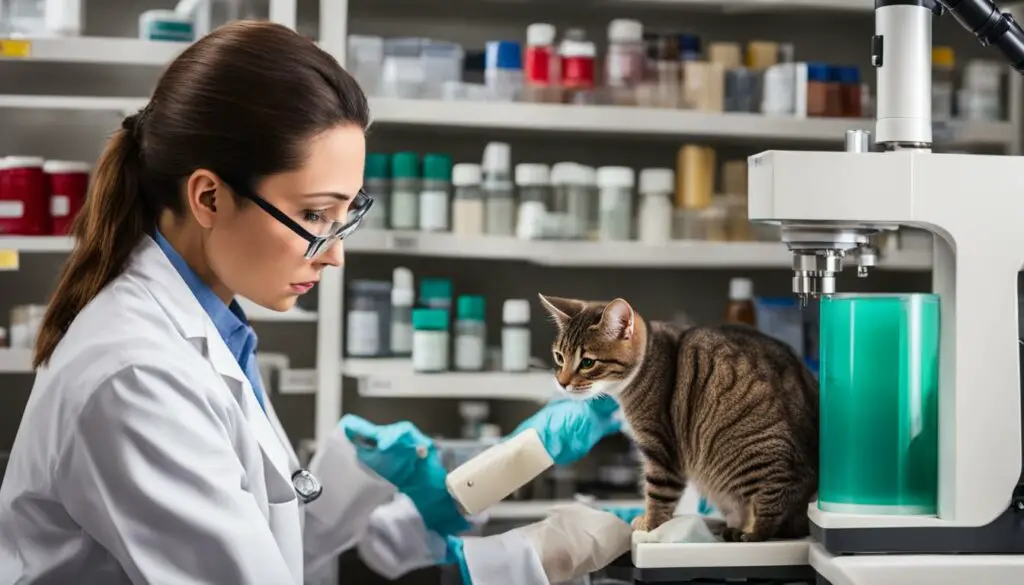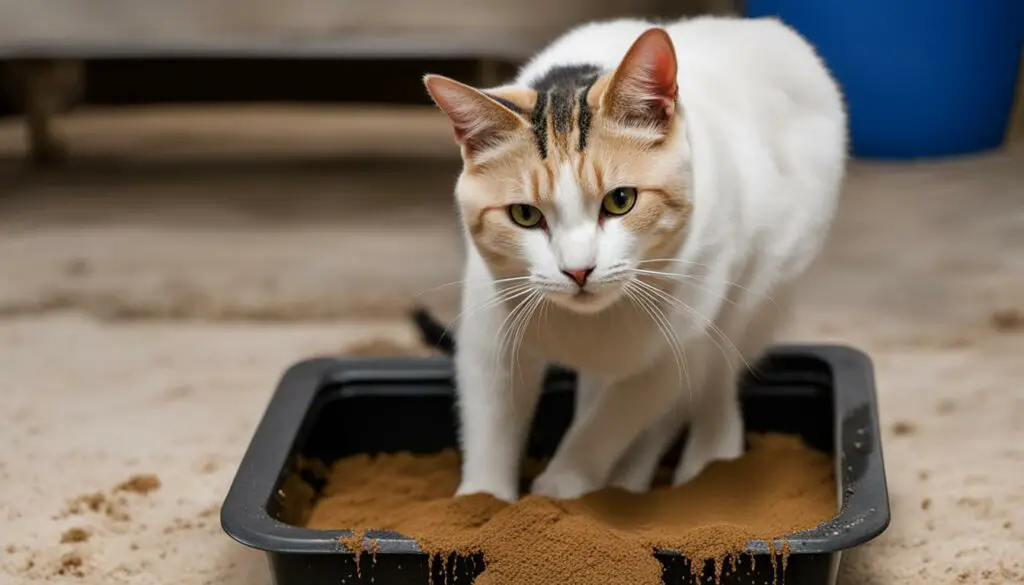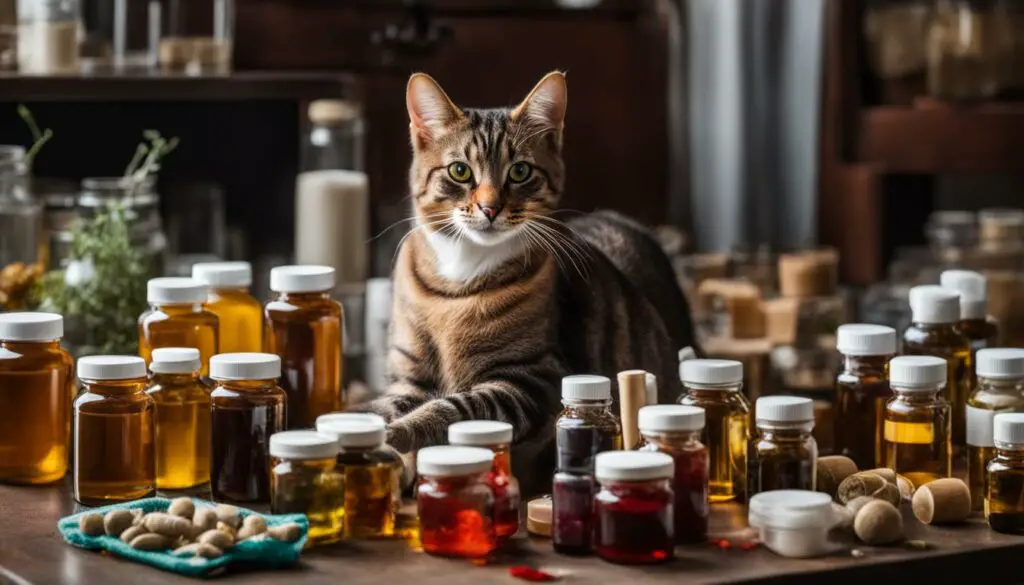Discovering blood in your male cat’s urine can be alarming. However, it’s important to note that despite this concerning symptom, your cat may still appear to be behaving normally. In this article, I will delve into the possible reasons behind a male cat peeing blood while seemingly unaffected. By understanding the underlying causes and seeking appropriate veterinary care, you can ensure your feline friend’s well-being.
Key Takeaways:
- Blood in a male cat’s urine, known as haematuria, should always be taken seriously and investigated by a veterinarian.
- While male cats may exhibit normal behavior despite peeing blood, it is crucial to rule out any underlying health issues.
- Symptoms of a male cat peeing blood include increased frequency of urination, pain during urination, and excessive licking of the urinary area.
- Possible causes of blood in a male cat’s urine include urinary tract infections, crystals or stones in the urinary tract, and injuries.
- Diagnostic tests such as urinalysis, bacterial cultures, blood tests, and imaging can help determine the underlying disorder.
Symptoms of a Male Cat Peeing Blood
If you notice your male cat urinating blood but showing no signs of illness, it is important to pay attention to any accompanying symptoms that may indicate an underlying issue. Some common signs to look out for include:
- Urinating more frequently: If your cat is visiting the litter box more often than usual, it could be a sign of a urinary problem.
- Pain during urination: Watch for signs of discomfort or vocalization while your cat is urinating.
- Excessive licking of the urinary area: Your cat may try to alleviate discomfort by grooming the genital area excessively.
- Prolonged squatting in the litter tray: If your cat is spending longer periods in the litter box without producing much urine, it may be a cause for concern.
- Avoiding the litter tray: Your cat may start urinating outside the litter box as a way of expressing discomfort.
- Ammonia-like smell in urine: A strong, unusual odor in your cat’s urine can be an indication of an issue.
- Increased thirst: Excessive thirst can be a sign of various underlying conditions.
- Vomiting: If your cat is vomiting along with urinating blood, it may be a sign of a more serious problem.
- Lethargy: Cats that are lethargic or appear weak may be experiencing health issues.
It is important to note that these symptoms may vary depending on the specific underlying cause of the blood in your cat’s urine. If you observe any of these signs, it is crucial to consult with a veterinarian for a proper diagnosis and appropriate treatment.
| Signs of Blood in Cat Urine | Description |
|---|---|
| Urinating more frequently | Increased visits to the litter box |
| Pain during urination | Discomfort or vocalization while urinating |
| Excessive licking of the urinary area | Overgrooming the genital area to alleviate discomfort |
| Prolonged squatting in the litter tray | Spending longer periods in the litter box with minimal urination |
| Avoiding the litter tray | Urinating outside the litter box due to discomfort |
| Ammonia-like smell in urine | Strong and unusual odor in the cat’s urine |
| Increased thirst | Excessive drinking of water |
| Vomiting | Expelling the stomach’s contents along with urinating blood |
| Lethargy | Weakness or lack of energy |
By recognizing these symptoms, you can provide valuable information to your veterinarian, aiding in the diagnosis and treatment of your male cat’s condition.

Possible Causes of Blood in a Male Cat’s Urine
When a male cat is peeing blood but showing no other symptoms, there are several potential causes that could be responsible. It is important to identify the underlying issue to ensure proper treatment and the overall well-being of your cat.
Infections and Inflammation
One possible cause of blood in a male cat’s urine is a urinary tract infection (UTI). Bacteria can enter the urinary system, causing inflammation and blood in the urine. UTIs can occur due to various factors such as bladder stones, stress, or a weakened immune system.
Urinary Tract Obstruction
Another potential cause is a urinary tract obstruction, often caused by the presence of crystals or stones in the urinary tract. These obstructions can disrupt the normal flow of urine, leading to blood in the urine. It is important to note that this condition can be life-threatening and requires immediate veterinary attention.
Trauma or Injury
Injury to the urinary tract, bladder, or kidneys can result in blood in a male cat’s urine. This could be due to accidents, fights, or other physical traumas. It is essential to rule out any possible injuries and provide appropriate care to prevent further complications.
| Possible Causes of Blood in a Male Cat’s Urine | Description |
|---|---|
| Infections and Inflammation | Urinary tract infections or inflammation can lead to blood in the urine. |
| Urinary Tract Obstruction | Obstruction in the urinary tract from crystals or stones can cause blood in the urine. |
| Trauma or Injury | Injury to the urinary system can result in blood in the urine. |
If you notice blood in your male cat’s urine, it is important to consult a veterinarian for a proper diagnosis. A thorough examination, including urinalysis and potentially other diagnostic tests, will help determine the specific cause. Remember, early detection and treatment are key to ensuring your cat’s health and well-being.
Determining the Underlying Disorder
When a male cat is peeing blood, it is crucial to determine the underlying disorder to provide appropriate treatment. Veterinary diagnosis typically involves a range of tests to assess the cat’s urinary health and identify the cause of the hematuria.
The initial step in the diagnostic process is a thorough physical examination conducted by a veterinarian. This examination helps to evaluate the overall health of the cat and identify any visible abnormalities. The vet will also review the cat’s health history and discuss any symptoms or changes in behavior that may be relevant.
Urinalysis is a common diagnostic test performed to analyze the composition of the cat’s urine. It helps detect the presence of red blood cells, white blood cells, bacteria, crystals, and other substances that may indicate an underlying condition.
In some cases, additional tests may be necessary, such as bacterial cultures to identify any specific bacteria causing infection, blood tests to evaluate organ function and check for any systemic abnormalities, X-rays to examine the urinary tract for stones or other obstructions, and ultrasound examinations to visualize the bladder and kidneys for abnormalities or tumors.

| Diagnostic Tests for Blood in Cat’s Urine | Purpose |
|---|---|
| Physical examination | Assess overall health and identify visible abnormalities |
| Urinalysis | Analyze urine composition and identify potential causes of blood |
| Bacterial cultures | Identify specific bacteria causing infection |
| Blood tests | Evaluate organ function and check for systemic abnormalities |
| X-rays | Examine the urinary tract for stones or obstructions |
| Ultrasound examinations | Visualize the bladder and kidneys for abnormalities or tumors |
Appropriate Treatment for Blood in Cat Urine
When a male cat is peeing blood, it is crucial to provide appropriate treatment to address the underlying cause and ensure the cat’s well-being. The specific treatment options will depend on the diagnosis made by the veterinarian.
One common treatment for blood in cat urine is the administration of antibiotics to combat any infections that may be present. Antibiotics can help eliminate bacteria in the urinary tract and reduce inflammation. In some cases, intravenous fluids may also be necessary to address dehydration and maintain the cat’s hydration levels.
In more severe cases, surgery may be required to remove kidney stones or tumors that are causing the blood in the urine. Surgery can also be necessary to resolve blockages in the urinary tract, which can lead to life-threatening complications if left untreated.
Additionally, special diets or urinary dissolvers may be prescribed to dissolve crystals or stones in the urinary tract and prevent their formation in the future. Medications may also be prescribed to treat bleeding disorders caused by toxins.

| Treatment Options | Description |
|---|---|
| Antibiotics | Administered to combat infections in the urinary tract and reduce inflammation. |
| Intravenous fluids | Given to address dehydration and maintain hydration levels. |
| Surgery | Performed to remove kidney stones or tumors and resolve blockages in the urinary tract. |
| Special diets or urinary dissolvers | Prescribed to dissolve crystals or stones in the urinary tract and prevent their formation. |
| Medications for bleeding disorders | Used to treat bleeding disorders caused by toxins. |
It is essential to follow the veterinarian’s recommendations and complete the prescribed treatment to ensure the best possible outcome for the cat. Regular check-ups and close monitoring of the cat’s condition are also important to evaluate the effectiveness of the treatment and make any necessary adjustments.
Complications and Recovery
When a male cat is peeing blood, there are several potential complications that may arise. One such complication is the risk of a blockage in the urinary tract. If a cat is unable to urinate freely, it can be a life-threatening situation and requires immediate veterinary attention. Signs of a blockage include straining to urinate, frequent trips to the litter tray with little or no urine produced, and signs of discomfort or distress.
Other complications can occur as a result of the underlying condition causing the blood in the cat’s urine. For example, if the cause is a urinary tract infection, there is a risk of the infection spreading to the kidneys, which can lead to more severe illness and potentially irreversible damage to the kidneys.
Recovery from blood in the cat’s urine depends on the underlying cause and the effectiveness of the treatment. With appropriate treatment, including antibiotics, pain relievers, special diets, and other medications as needed, cats should start to show improvement within a few days. They should return to using the litter box consistently, and the blood in their urine should gradually subside. However, it is important to follow the veterinarian’s instructions and attend all follow-up visits to ensure a full recovery and monitor for any potential complications.

Complications of Blood in Cat Urine
When a male cat is peeing blood, there are several potential complications that may arise. One such complication is the risk of a blockage in the urinary tract. If a cat is unable to urinate freely, it can be a life-threatening situation and requires immediate veterinary attention. Signs of a blockage include straining to urinate, frequent trips to the litter tray with little or no urine produced, and signs of discomfort or distress.
Other complications can occur as a result of the underlying condition causing the blood in the cat’s urine. For example, if the cause is a urinary tract infection, there is a risk of the infection spreading to the kidneys, which can lead to more severe illness and potentially irreversible damage to the kidneys.
Recovery from blood in the cat’s urine depends on the underlying cause and the effectiveness of the treatment. With appropriate treatment, including antibiotics, pain relievers, special diets, and other medications as needed, cats should start to show improvement within a few days. They should return to using the litter box consistently, and the blood in their urine should gradually subside. However, it is important to follow the veterinarian’s instructions and attend all follow-up visits to ensure a full recovery and monitor for any potential complications.

Complications and Recovery
When a male cat is peeing blood, there are several potential complications that may arise. One such complication is the risk of a blockage in the urinary tract. If a cat is unable to urinate freely, it can be a life-threatening situation and requires immediate veterinary attention. Signs of a blockage include straining to urinate, frequent trips to the litter tray with little or no urine produced, and signs of discomfort or distress.
Other complications can occur as a result of the underlying condition causing the blood in the cat’s urine. For example, if the cause is a urinary tract infection, there is a risk of the infection spreading to the kidneys, which can lead to more severe illness and potentially irreversible damage to the kidneys.
Recovery from blood in the cat’s urine depends on the underlying cause and the effectiveness of the treatment. With appropriate treatment, including antibiotics, pain relievers, special diets, and other medications as needed, cats should start to show improvement within a few days. They should return to using the litter box consistently, and the blood in their urine should gradually subside. However, it is important to follow the veterinarian’s instructions and attend all follow-up visits to ensure a full recovery and monitor for any potential complications.
| Complications of Blood in Cat Urine | Blockage Risk | Follow-Up Visits |
|---|---|---|
| Blockage in the urinary tract | If the cat is unable to urinate freely, it can be life-threatening | Regular follow-up visits are necessary to monitor recovery |
| Infection spreading to the kidneys | Risk of more severe illness and potentially irreversible kidney damage | Ensure proper treatment and monitor for any complications |
Table: Complications of blood in cat urine, blockage risk, and the importance of follow-up visits.
Discussing Euthanasia as a Last Resort
When a male cat is peeing blood but acting normal, it can be a distressing situation for pet owners. While it is essential to explore all possible treatment options, there are rare cases where euthanasia may be considered as a last resort to alleviate the suffering of the cat. This difficult decision should not be taken lightly, and seeking guidance from trained and qualified home visit vets can provide the necessary support during this emotional time.
Euthanasia is a humane option to consider when all treatment options have been exhausted, and the cat’s quality of life is significantly compromised due to a severe and incurable condition. These conditions may include advanced stages of cancer affecting the urinary system, kidney failure, or irreparable damage to the urinary tract. It is important to consult with a veterinarian who can assess the cat’s overall health, provide detailed information about the prognosis, and guide the decision-making process.
Home visit vets specialize in providing compassionate end-of-life care for pets in the comfort of their own homes. They are trained to handle euthanasia procedures with the utmost care, ensuring that the cat experiences minimal stress and discomfort during the process. These veterinary professionals can also offer emotional support to pet owners, allowing them to say their final goodbyes in a familiar and peaceful environment.
| Advantages of Home Visit Vets for Euthanasia | Considerations for Euthanasia |
|---|---|
|
|
“Saying goodbye to a beloved pet is one of the most difficult decisions a pet owner can make. As a home visit vet, I am dedicated to providing compassionate care, ensuring that the euthanasia process is as peaceful and comfortable as possible for both the pet and the owner. My goal is to support pet owners during this challenging time and help them make the best decision for their furry family member.” – Dr. Emily Thompson, Home Visit Vet
It is important to remember that euthanasia should only be considered after all viable treatment options have been thoroughly explored and the cat’s quality of life is severely compromised. Open and honest communication with a trusted veterinarian is crucial in making the best decision for your cat’s well-being. While it is a heartbreaking choice to make, euthanasia can provide a compassionate and dignified end for a beloved feline companion.

Seeking Veterinary Help for a Male Cat Peeing Blood
If you notice that your male cat is peeing blood and showing signs of distress or inability to urinate, it is crucial to seek immediate veterinary help. This is not a situation that can be ignored or delayed, as it may indicate a serious underlying condition that requires prompt treatment.
When it comes to blood in a cat’s urine, time is of the essence. The urgency of veterinary care cannot be overstated. A vet will be able to conduct the necessary tests to evaluate the underlying cause of the blood and recommend appropriate treatment options.
Remember, cats are masters at hiding their pain or discomfort. Even if your male cat is acting normal despite peeing blood, it is still essential to take action. Contact your veterinarian for an appointment and be prepared for diagnostic tests such as blood and urine samples, urine cultures, viral testing, x-rays, or ultrasound examinations. Early detection and intervention can make a significant difference in the outcome for your furry friend.
Recognizing the Urgency of Veterinary Care
Some possible signs that indicate the need for immediate veterinary help include:
- Visible blood in the cat’s urine
- Straining or crying out while attempting to urinate
- Frequent urination or inability to urinate
- Increased agitation or restlessness
- Lethargy or loss of appetite
If you observe any of these symptoms, do not hesitate to contact your vet. They are the best source of guidance and expertise when it comes to diagnosing and treating a male cat peeing blood.
| Urgent Signs | Non-Urgent Signs |
|---|---|
| Blood in urine | Increased thirst |
| Pain or discomfort during urination | Vomiting |
| Excessive licking of the urinary area | Lethargy |
| Prolonged squatting in the litter tray | Ammonia-like smell in urine |
| Avoiding the litter tray |
Remember, your male cat’s well-being is in your hands. If you suspect any urinary issues or notice blood in their urine, do not delay seeking veterinary help. Your quick response can make a significant difference in their treatment and recovery.

Taking Action for a Cat Urinating Blood
If you notice that your cat is urinating blood but otherwise acting normal, it is crucial to take action promptly. Contacting a veterinarian is the first step towards ensuring your cat’s health and well-being. A vet will be able to guide you through the necessary diagnostic tests to determine the underlying cause of the blood in your cat’s urine.
The diagnostic tests may include blood and urine samples, urine cultures, viral testing, x-rays, or ultrasound examinations. These tests will help the vet identify any infections, urinary tract issues, stones, or other potential causes for the blood in your cat’s urine. It is important to follow their recommendations and instructions to ensure an accurate diagnosis.
Based on the diagnosis, the veterinarian will develop a tailored treatment plan for your cat. This may include medications, antibiotics, pain relievers, special diets, or other interventions depending on the underlying cause. Following the vet’s recommended treatment plan is crucial for your cat’s recovery.

Remember to closely monitor your cat’s behavior and alert the vet if there are any changes or concerns during the treatment process. Additionally, it is important to maintain regular follow-up visits with the vet to assess your cat’s progress and make any necessary adjustments to the treatment plan. By taking action and seeking veterinary help, you can ensure the best possible care and outcome for your cat.
Using Veterinary Recommendations for FLUTD
If your cat has been diagnosed with Feline Lower Urinary Tract Disease (FLUTD), it is crucial to follow your veterinarian’s recommendations. FLUTD is a common urinary issue in cats that can cause discomfort and pain. To effectively manage FLUTD, your veterinarian may suggest a combination of treatments to alleviate symptoms and prevent recurrence.

One of the key recommendations for managing FLUTD is to provide your cat with a special diet. These diets are formulated to promote urinary health by controlling mineral levels and maintaining proper pH balance in the urine. By feeding your cat the recommended diet, you can help prevent the formation of crystals or stones in the urinary tract, which are common contributors to FLUTD. It is important to strictly adhere to the feeding guidelines provided by your veterinarian, as even small deviations from the recommended diet can affect its effectiveness.
In addition to dietary changes, your veterinarian may also prescribe medications to relieve pain and reduce inflammation in the urinary tract. These medications can help alleviate discomfort and promote healing. It is crucial to administer the medications as instructed and complete the full course of treatment, even if your cat’s symptoms improve. Skipping doses or stopping treatment prematurely can lead to a recurrence of symptoms or the development of antibiotic resistance. Regular follow-up appointments with your veterinarian are important to monitor your cat’s progress and make any necessary adjustments to the treatment plan.
Summary:
- Follow your veterinarian’s recommendations for managing FLUTD in your cat.
- Feed your cat a special diet formulated to promote urinary health, as recommended by your veterinarian.
- Administer any prescribed medications as instructed and complete the full course of treatment.
- Schedule regular follow-up appointments with your veterinarian to monitor your cat’s progress and make necessary adjustments to the treatment plan.
Table:
| Treatment Option | Description |
|---|---|
| Dietary Changes | Feeding a special diet formulated for urinary health to prevent the formation of crystals or stones in the urinary tract. |
| Medications | Prescribing pain relievers and anti-inflammatory drugs to alleviate discomfort and promote healing in the urinary tract. |
| Follow-Up Appointments | Scheduling regular check-ups with the veterinarian to monitor your cat’s progress and make any necessary adjustments to the treatment plan. |
Importance of Timely Treatment for Blood in Cat Urine
Timely treatment for blood in a cat’s urine is crucial to prevent the progression of infections and potential complications. If left untreated, conditions causing blood in a cat’s urine can worsen, leading to more severe health issues.
Blood in a cat’s urine, known as hematuria, can be a sign of underlying problems such as urinary tract infections, crystals or stones in the urinary tract, injuries, or even cancer affecting the urinary system. Seeking veterinary help promptly allows for a proper diagnosis and the implementation of appropriate treatment options.
A timely visit to the vet can help identify the underlying cause of the blood in the urine through tests such as urinalysis, bacterial cultures, blood tests, X-rays, and ultrasound examinations. These diagnostic tests provide valuable insights, enabling veterinarians to develop an effective treatment plan tailored to the specific condition.
| Consequences of Untreated Blood in Cat Urine |
|---|
| Progression of Infections |
| Without timely treatment, a simple urinary tract infection can progress to more severe infections, such as kidney infections. These can result in decreased kidney function and potentially irreversible damage. It is crucial to address blood in a cat’s urine promptly to prevent further harm and ensure the best possible outcome for the cat’s health. |
Remember, as a responsible pet owner, it is essential to monitor your cat’s behavior and seek veterinary attention if you notice any signs of blood in their urine. Prompt treatment can prevent complications, promote a speedy recovery, and help your beloved feline companion return to their normal, healthy self.

Behavioral Changes in Cats Peeing Blood
When a cat is urinating blood, it is not uncommon for them to exhibit behavioral changes. These changes can provide important clues about their health and can help guide the diagnosis and treatment process. If you notice any of the following behaviors in your cat, it is crucial to seek immediate veterinary attention.
- Peeing outside the litter box: Cats may urinate outside their litter box if they are experiencing discomfort or pain while urinating. This behavior can indicate a urinary tract infection, bladder stones, or other underlying conditions.
- Increased frequency of urination: Cats with blood in their urine may feel the need to urinate more frequently than usual. This can be a sign of inflammation or irritation in the urinary tract.
- Struggling to urinate: Straining or difficulty in urinating is a red flag that should not be ignored. It could indicate a blockage in the urinary tract, which can become life-threatening if not treated promptly.
Cats are known for their ability to hide pain and discomfort, so it’s crucial to pay close attention to changes in their behavior. If you observe any of these signs, it is essential to consult with a veterinarian as soon as possible. Prompt diagnosis and treatment can help alleviate your cat’s discomfort and prevent any potential complications.

In summary, behavioral changes in cats peeing blood can be indicative of underlying health issues that require veterinary attention. These changes may include peeing outside the litter box, increased frequency of urination, and struggling to urinate. It is crucial to monitor your cat’s behavior closely and consult with a veterinarian if you notice any abnormal behaviors. Remember, early intervention can make a significant difference in your cat’s health and well-being.
Tailored Treatment for Cats with Blood in Urine
When it comes to treating cats with blood in their urine, the approach will depend on the underlying cause. Veterinary professionals may recommend a combination of treatment options to address the specific needs of your cat. Some common treatments for cats peeing blood include:
- Antibiotics: If a urinary tract infection is the cause of blood in your cat’s urine, antibiotics may be prescribed to eliminate the infection and reduce inflammation.
- Pain relievers: In cases where your cat is experiencing discomfort or pain, your veterinarian may recommend pain relievers to help alleviate these symptoms.
- Special diets: Certain diets formulated specifically for cats with urinary issues may be suggested. These diets are designed to promote proper urinary health and reduce the likelihood of recurring blood in the urine.
It is important to note that the treatment options mentioned above are not exhaustive, as each cat’s situation is unique. Your veterinarian will tailor the treatment plan based on the diagnosis and individual needs of your feline companion. Regular follow-up visits and open communication with your vet are essential for evaluating treatment success and making any necessary adjustments.
“Treating cats with blood in their urine requires a personalized approach, considering the underlying cause and the specific needs of each cat. Antibiotics, pain relievers, and special diets are some of the treatment options veterinarians may recommend.”
| Treatment Options | Description |
|---|---|
| Antibiotics | Prescribed to eliminate infections causing blood in the urine and reduce inflammation. |
| Pain relievers | Recommended to alleviate discomfort or pain experienced by the cat. |
| Special diets | Formulated to promote urinary health and reduce the likelihood of recurring blood in the urine. |
By following the prescribed treatment plan and providing necessary care, your cat’s condition should improve over time. Regular monitoring and communication with your veterinarian will help ensure the best possible outcome for your cat’s health and well-being.

Expectations for Recovery in Cats Peeing Blood
When a male cat is peeing blood, it is natural to be concerned about their well-being. Fortunately, with appropriate treatment, cats with blood in their urine can recover and return to their normal behavior. It is important to understand the recovery process and what to expect during this time.
After starting treatment, you can expect to see improvement in your cat’s condition within a couple of days. They should begin to use the litter box consistently and the blood in their urine should subside. It is important to note that individual recovery times may vary depending on the underlying cause of the blood in their urine, so it’s best to consult with your veterinarian for a more specific timeline.
During the recovery period, it is crucial to closely monitor your cat’s progress and follow any prescribed medication schedules. If your cat experiences any gastrointestinal upset from oral medications, it is important to consult with your veterinarian to find alternative solutions. Additionally, it is essential to attend all follow-up visits with your vet to ensure that your cat is on the right track to recovery.
Creating a stress-free environment for your cat is also important during the recovery process. Minimize any potential sources of stress, such as loud noises or changes in their routine, as this can hinder their healing progress. Providing a calm and quiet space for them to rest and recuperate can significantly aid in their recovery.
| Recovery in Cats Peeing Blood | Key Points |
|---|---|
| Timeline | Improvement within a couple of days, individual recovery times may vary |
| Monitoring | Closely monitor your cat’s progress and follow prescribed medication schedules |
| Follow-up Visits | Attend all follow-up visits with your veterinarian |
| Stress-Free Environment | Create a calm and quiet space for your cat to rest and recover |
In conclusion, cats with blood in their urine can recover and return to their normal behavior with proper treatment and care. It is important to be patient during the recovery period, closely monitor their progress, and follow your veterinarian’s guidance. By providing a stress-free environment and attending follow-up visits, you can ensure your cat’s successful recovery. If you have any concerns or questions about your cat’s recovery, do not hesitate to reach out to your veterinarian for further assistance.

Taking Care of Cats with Urinary Issues
When it comes to caring for cats with urinary issues, maintaining a stress-free environment is key. Providing a calm and comfortable space for your feline friend can help alleviate any anxiety or stress that may worsen their condition. Here are a few essential tips to ensure the well-being of your cat:
- Keep your cat indoors: Keeping your cat indoors can minimize exposure to potential stressors, such as territorial disputes or encounters with other animals. It also reduces the risk of accidents or injuries that could further aggravate their urinary issues.
- Provide fresh water and appropriate diet: Ensuring that your cat has access to plenty of fresh water is crucial for maintaining their urinary health. Additionally, consult with your veterinarian about the most suitable diet for your cat’s specific condition. Specialized diets may be recommended to promote urinary health and prevent further complications.
- Administer prescribed medications: If your cat has been prescribed medication, it is important to administer it as directed by your veterinarian. This may include antibiotics, pain relievers, or other medications specific to their condition. Following the prescribed treatment plan will help manage their symptoms and promote recovery.
- Monitor behavior and attend follow-up visits: Keep a close eye on your cat’s behavior and monitor any changes in their urination patterns or overall well-being. If you notice any concerning signs or symptoms, contact your veterinarian. It is also essential to attend all scheduled follow-up visits to ensure that your cat’s progress is monitored and any necessary adjustments to their treatment plan can be made.
By following these guidelines and providing your cat with the necessary care and attention, you can help support their recovery and promote their overall urinary health. Remember, any concerns or questions regarding your cat’s condition should be addressed with a qualified veterinarian for accurate diagnosis and personalized treatment.
| Caring Tips for Cats with Urinary Issues | Keywords |
|---|---|
| Keep your cat indoors | caring for cats with urinary problems |
| Provide fresh water and appropriate diet | maintaining stress-free environment |
| Administer prescribed medications | caring for cats with urinary problems |
| Monitor behavior and attend follow-up visits | maintaining stress-free environment |
Conclusion
Understanding the causes and treatment options for male cats peeing blood but acting normal is crucial for their overall well-being. Although it can be alarming to discover blood in a cat’s urine, it’s important to remain calm and seek veterinary help promptly.
By visiting a vet, you can rule out any underlying health issues and ensure that your cat receives appropriate treatment. From urinary tract infections to kidney stones, there are various possible causes for blood in a male cat’s urine.
Following the vet’s recommendations, such as administering antibiotics or adjusting your cat’s diet, can lead to a successful recovery. Regular check-ups and close monitoring of your cat’s behavior are key to maintaining their urinary health and overall happiness. Remember, a stress-free environment and open communication with your vet are essential for your cat’s continued well-being.
Remember, if you notice your male cat urinating blood but otherwise acting normal, it’s crucial to take action. By understanding the causes and seeking appropriate treatment, you can ensure the best possible outcome for your cat’s health. Their well-being is in your hands, so prioritize their urinary health and provide them with the care they deserve.
FAQ
What are the symptoms of a male cat peeing blood?
Symptoms may include urinating more frequently, pain during urination, excessive licking of the urinary area, prolonged squatting in the litter tray, avoiding the litter tray, ammonia-like smell in urine, increased thirst, vomiting, and lethargy.
What are the possible causes of blood in a male cat’s urine?
Several factors can contribute to blood in a male cat’s urine, such as a non-spayed female cat in heat, dehydration, urinary tract infection, crystals or stones in the urinary tract, injuries, medication overdose, poisoning, and cancer affecting the urinary system.
How can the underlying disorder causing blood in a male cat’s urine be determined?
A vet will conduct a physical examination of your male cat and may perform diagnostic tests such as urinalysis, bacterial cultures, blood tests, X-rays, and ultrasound examinations of the bladder and urethra.
What is the appropriate treatment for blood in a male cat’s urine?
Treatment options may include antibiotics for infection, intravenous fluids for dehydration, gradual withdrawal of steroid medication, surgery for kidney stones or tumors, special diets or urinary dissolvers, and medications to treat bleeding disorders caused by toxins.
What are the complications and recovery process for a male cat peeing blood?
Complications can include blockage, and recovery depends on the underlying cause. Cats receiving treatment should be kept indoors for close monitoring, follow prescribed medication schedules, maintain a stress-free environment, and attend all follow-up visits with the vet.
When should euthanasia be considered as a last resort?
In some cases, if all treatment options fail, euthanasia may be considered. Trained and qualified home visit vets can provide guidance and support during this difficult decision-making process.
When should I seek veterinary help for a male cat peeing blood?
If your male cat is peeing blood and showing signs of distress or inability to urinate, immediate veterinary help is required. A vet will conduct tests to assess the underlying cause and recommend appropriate treatment options.
What steps should I take if my cat is urinating blood?
If your cat is urinating blood but otherwise acting normal, it is still important to take action. Contact your veterinarian for an appointment and be prepared for diagnostic tests such as blood and urine samples, urine cultures, viral testing, x-rays, or ultrasound examinations.
How should I follow veterinary recommendations for feline lower urinary tract disease (FLUTD)?
If your cat has been diagnosed with FLUTD, it is crucial to follow your veterinarian’s recommendations. Use the recommended veterinary diet, increase water intake, and consult with your vet for any relapses or changes in diet.
Why is timely treatment for blood in a cat’s urine important?
If left untreated, conditions causing blood in a cat’s urine can worsen and lead to serious complications. Seeking timely veterinary help is crucial to prevent further harm.
What behavioral changes may cats exhibit when peeing blood?
Cats experiencing blood in their urine may exhibit behavioral changes such as peeing more frequently, urinating outside the litter box, or struggling to urinate. These signs indicate the need for immediate veterinary attention.
What is the tailored treatment for cats with blood in their urine?
Treatment for cats with blood in their urine may include antibiotics, pain relievers, special calming diets, and dietary supplements. Individualized treatment plans will be created by the veterinarian based on the diagnosis.
What can I expect in terms of recovery for cats peeing blood?
With appropriate treatment, cats with blood in their urine should start to show improvement within a couple of days. They should return to using the litter box consistently, and the blood in their urine should subside. However, if any gastrointestinal upset occurs from oral medications, consult the veterinarian.
How can I take care of cats with urinary issues?
Cats with urinary issues should be kept indoors, provided with enough water and the prescribed medication, and their diets may need to be adjusted. Monitoring their behavior and attending regular follow-up visits with the vet are essential for their ongoing care and well-being.







